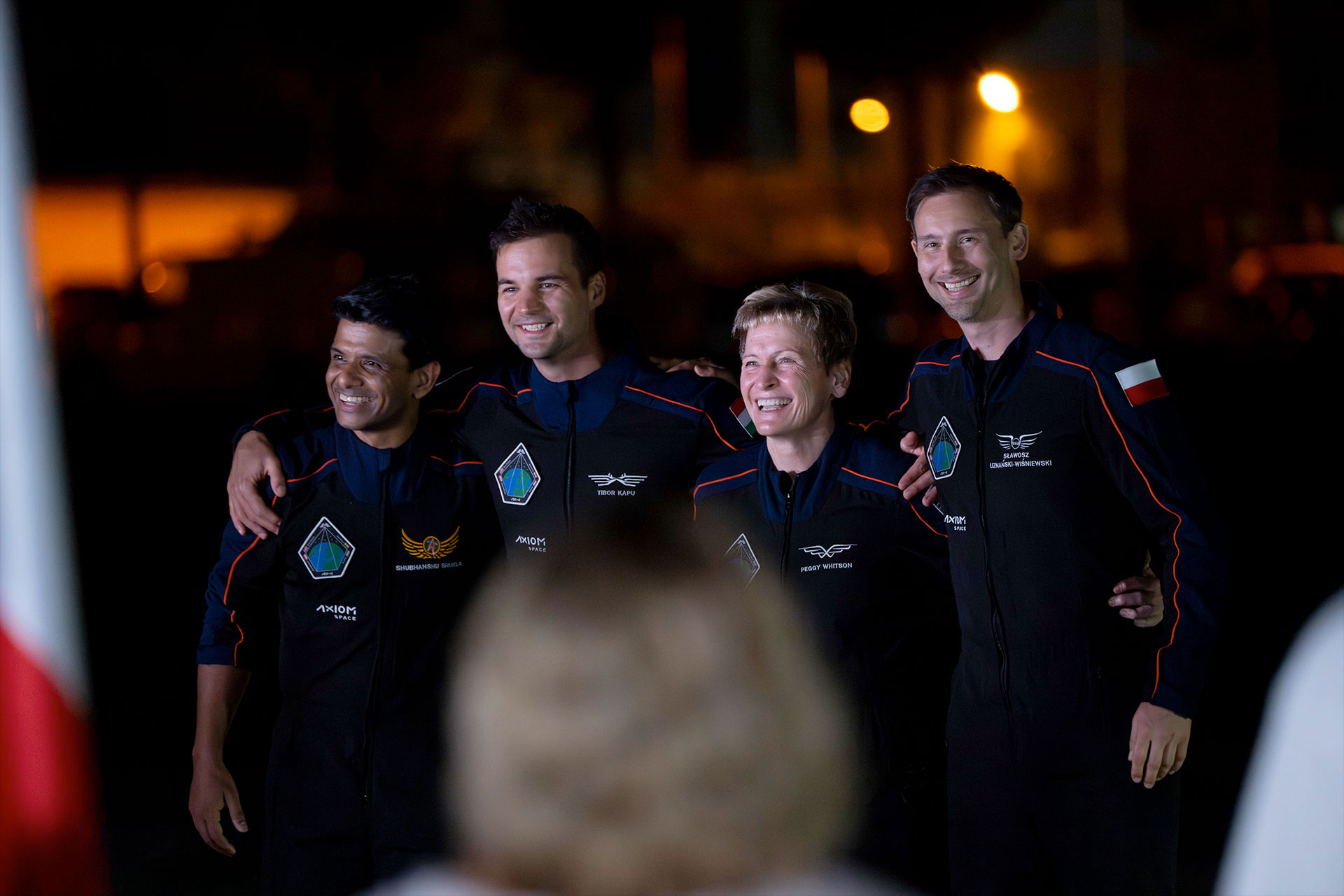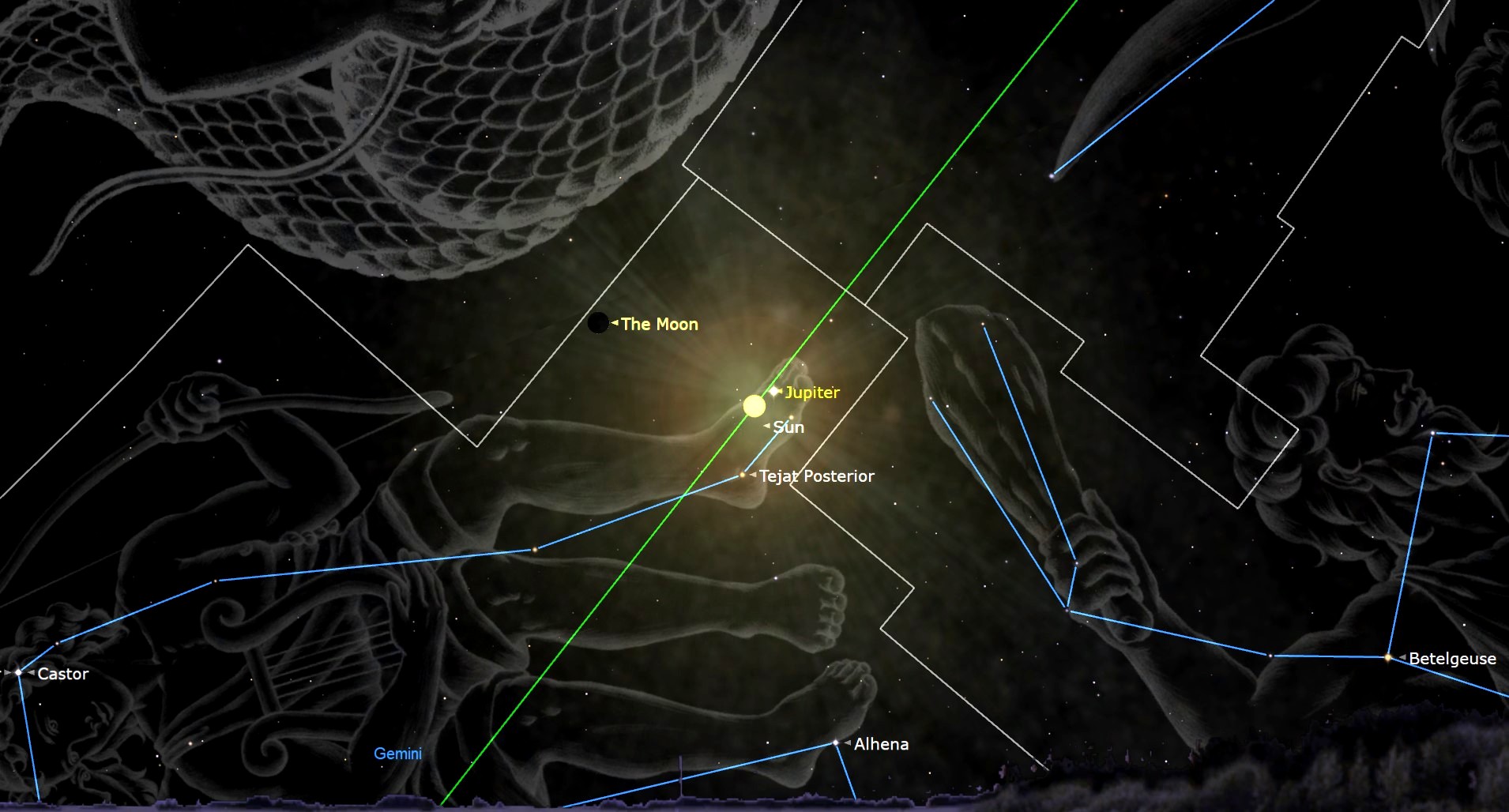SpaceX launches historic private Axiom-4 astronaut mission to the ISS (video)
Ax-4 is carrying the first ever-people from India, Hungary and Poland to launch on a mission to the orbiting lab.
A newborn Dragon has just roared into space.
SpaceX's newest Dragon spacecraft launched on its debut mission this morning (June 25), sending the four-person Ax-4 mission to the International Space Station (ISS) for Houston-based company Axiom Space.
Ax-4's SpaceX Falcon 9 rocket lifted off at 2:31 a.m. EDT (0631 GMT) this morning from Launch Complex-39A at NASA's Kennedy Space Center.
As is tradition, the crew of a spacecraft's first launch are awarded naming rights. That honor fell to Ax-4 for this new Dragon; the astronauts named it "Grace," which they revealed once they reached the orbit.

Originally slated to launch June 11, the mission has faced two full weeks of delays. High altitude winds postponed Ax-4's first attempt. A leak in the launch vehicle caused another delay, but the most recent, and longest standing holdup of the launch was a leak aboard the ISS.
The station's aftmost module, Zvezda, has experienced an ongoing leak for more than five years now, but has remained stable during that time. Last week, a change in the pressure data that monitors the leak prompted NASA to delay Ax-4 while they monitored the issue. Monday, June 23, NASA announced Ax-4's new launch date, but did not provide a definitive update on the leak.
Ax-4 is commanded by former NASA astronaut Peggy Whitson, who is currently Axiom's director of human spaceflight. She's joined on the mission by pilot Shubhanshu Shukla and mission specialists Sławosz Uznański-Wiśniewski and Tibor Kapu.
Breaking space news, the latest updates on rocket launches, skywatching events and more!
This is the first spaceflight for the latter trio, who are also the first from their countries— India, Poland and Hungary, respectively — to fly a mission to the ISS. Ax-4 is Whitson's fifth launch to orbit, and will bring her cumulative time spent in space to nearly 700 days, extending her own record as the United States' most-flown astronaut.
The Ax-4 quartet will spend about two weeks aboard the orbiting lab, where they'll conduct more than 60 science experiments and STEM (science, technology, engineering and math) outreach events — the highest number on any Axiom mission to date.

Shortly after sunset Tuesday evening, the Ax-4 crew boarded a pair of Tesla Model X SUVs outside KSC's Vehicle Assembly Building and departed for the sleeping Dragon awaiting them at the launch pad. With the crew safely strapped in and Dragon's hatch closed, the SpaceX mission operators polled "go" to begin fast-fueling Falcon 9's kerosene-liquid oxygen propellant at T-45 minutes.
At liftoff, the rocket's nine Merlin engines carried the Falcon 9 high into the starry Florida sky, pushing through Earth's atmosphere to complete its first phase of flight within the first two minutes. At approximately T+2.5 minutes, Falcon 9 executed main engine cutoff, followed immediately by stage separation and ignition of the rocket's second-stage engine and the first stage's initial boostback burn.
As the Falcon 9's second stage continued to carry Dragon and the Ax-4 crew into low-Earth orbit (LEO), the rocket's first stage headed back toward the Space Coast. The booster, with the tail number B1095, performed a second deceleration burn and final landing burn, touching down safely about 2.5 miles (4 kilometers) downrange of Pad 39A, on SpaceX's Landing Zone 1 at Cape Canaveral Space Force Station. This was the second flight of B1095, which launched the Starlink 12-15 mission May 20.
About a minute later, the Falcon 9's second stage completed its orbital insertion and deployed Dragon to begin the final leg of Ax-4's journey to the space station.
The crew shared images of their mission's zero-g indicator, a plush baby swan toy named Joy.
Poland, Hungary and India have all had astronauts fly to space before, but never to the ISS.
The Ax-4 crew will spend about 14 days aboard the space station. They'll live and work alongside the seven long-term occupants of ISS Expedition 73, which consists of NASA astronauts Anne McClain, Nichole Ayers and Jonny Kim, JAXA (Japan Aerospace Exploration Agency) astronaut Takuya Onishi and cosmonauts Sergey Ryzhikov, Kirill Peskov and Alexey Zubritsky.
Whitson voiced excitement for the mission and the opportunities created by flying with such a diverse crew during an Ax-4 press conference in January.
"It has been more than 40 years since the first person from India, Poland and Hungary has been to space, and through this commercial space opportunity we are accelerating the national space programs in each of these three countries and creating new pathways for technological advancements," Whitson said at the time. "I'm sure this crew is going to be inspiring a whole new generation of young people."
This is the second Axiom astronaut mission to the ISS that has been sponsored in part by another national government or the European Space Agency (ESA). Of the 60 experiments to be carried out by the Ax-4 crew, 17 are being supported by ESA and Poland, and 25 through Hungary's orbital astronaut program HUNOR.
"Each country who comes brings something different than what we have in the normal suite of what we see for our research," said NASA's ISS program manager Dana Weigel during a May 20 Ax-4 press call. "It really expands the breadth of what we can do with research and the number of countries, institutions, academic organizations, etc., who participate."
Shukla was born in 1985 — one year after the first Indian in space, Rakesh Sharma, launched aboard a Soyuz spacecraft on the Indo-Soviet Soyuz T-11 mission.
"I was deeply, deeply impressed by him," Shukla said during January's crew conference, referring to Sharma. Shukla is a pilot in the Indian Air Force, and was selected as one of the four astronauts for the Indian Space Research Organization's (ISRO) first human spaceflight mission, Gaganyaan, which is slated to launch sometime in 2027.
Uznański-Wiśniewski has been inspired by space his whole life, he told reporters in January. He was born on April 12, 1984 — the 23rd anniversary of Yuri Gagarin's historic first flight to space.
"For as long as I can remember, every year for my birthday, my mom was always wishing me a happy 'Cosmo day,'" he told reporters. "I was always interested in how the world works around us."
He's now a member of ESA's Astronaut Reserve Class of 2022 and an accomplished scientist and engineer, including a stint as engineer in charge of the Large Hadron Collider in Switzerland.
Kapu, the youngest of the group, was born in 1991. A mechanical engineer with a master's degree in polymer technology, Kapu's work focused on space radiation protection at an aerospace technology company until his selection by HUNOR's astronaut program.
"Our goal with the [HUNOR] program is to gain our foothold in the space community, to contribute to the global space industry and academia in all the ways we can, and to sit at the same table with the giants, with the bigger players," Kapu said in January.
The Ax-4 quartet will spend a little more than a day catching up to the ISS; Dragon is scheduled to dock with the dorsal port of the station's Harmony module at approximately 7:00 a.m. EDT (1100 GMT) Thursday, June 26.
A livestream of the mission's rendezvous procedures will begin a couple hours prior to docking, and will continue through hatch opening between Dragon and the ISS. That will be followed by a short welcome ceremony for the Ax-4 crew.
Ax-4 will remain docked to the ISS for about two weeks, as the crew work their way through the mission's gamut of science and technology demonstrations. Their return is scheduled sometime during the second week of July, and will be dependent, in part, on weather in the Dragon's splashdown zone.
The return of Ax-4 will be the second crew recovery of a Dragon off the United States' West Coast. SpaceX shifted its recovery efforts to the Pacific after several instances of debris from Dragon's discarded trunk survived atmospheric reentry, and crashed into Earth during previous splashdowns off the coast of Florida.
Join our Space Forums to keep talking space on the latest missions, night sky and more! And if you have a news tip, correction or comment, let us know at: community@space.com.

Josh Dinner is the Staff Writer for Spaceflight at Space.com. He is a writer and photographer with a passion for science and space exploration, and has been working the space beat since 2016. Josh has covered the evolution of NASA's commercial spaceflight partnerships and crewed missions from the Space Coast, as well as NASA science missions and more. He also enjoys building 1:144-scale model rockets and human-flown spacecraft. Find some of Josh's launch photography on Instagram and his website, and follow him on X, where he mostly posts in haiku.
You must confirm your public display name before commenting
Please logout and then login again, you will then be prompted to enter your display name.
